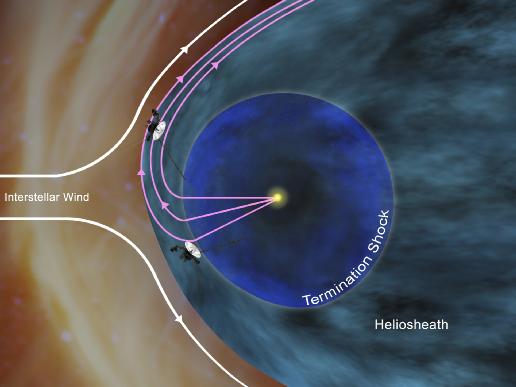Science News
Voyager at Magnetic Highway
December 4, 2012

As the AGU Meeting commences here in San Francisco, it’s a great time to share news about NASA’s Voyager mission. Not to be upstaged by news from the Curiosity mission, the Voyager probe has pulled off some exciting recent accomplishments, according to the ever-passionate Ed Stone, who has been with the mission for its entire 35 years (and then some).
Launched in 1977, Voyager 1 is the most distant human-made object in our galaxy, and is close to passing beyond the limits of our solar system. This week, the team announced that Voyager 1 has entered the “magnetic highway,” a region between the heliosphere and interstellar space. Scientists coined the new term “magnetic highway” to describe the place where the Sun’s magnetic field lines connect with interstellar magnetic field lines. As Stone said at yesterday’s meeting, “The new region isn’t what we expected, but we’ve come to expect the unexpected from Voyager.”
Voyager has three instruments on board to measure changes in the magnetic environment—one that detects the low-energy particles that come from the solar wind within the heliosphere; one that detects the high-energy particles from interstellar space (remnants from supernovae explosions millions of years ago); and a magnetometer, which measures the strength and direction of magnetic fields.
How do the scientists know the magnetic highway isn’t just interstellar space? First, both low- and high-energy particles are detected. Also, the magnetic field from the Sun runs east to west, and that should change dramatically once the spacecraft enters interstellar space.
Voyager 1 first merged onto this highway in late July, but then quickly exited. The same thing happened in early August, and finally Voyager entered for good in late August. Stone predicts that interstellar space can’t be too far for Voyager 1. “We believe this is the last leg of our journey to interstellar space,” Stone said. “Our best guess is it’s likely just a few months to a couple years away.” (Hopefully well before the spacecraft’s power is due to shut off in 2025.)
Because Voyager 1 is now located about 11 billion miles away from the Sun, the signal from the spacecraft takes approximately 17 hours to travel to Earth. Voyager 2, the longest continuously operated spacecraft, is about 9 billion miles away from our sun, headed in a completely different direction. While Voyager 2 has seen changes similar to those seen by Voyager 1, the changes are much more gradual. Scientists do not think Voyager 2 has yet reached the magnetic highway.